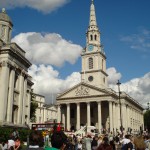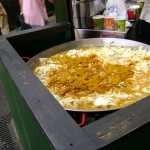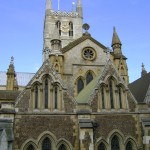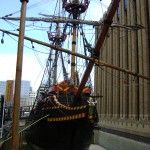Upon entering Saint-Martin-in-the-Fields, early this afternoon for the E.L.F. trio, I thought I had a pretty good idea of what to expect from the concert and the church. I’ve been in a good number of European churches, and I admit that I’ve gotten a bit jaded on the church front. I wasn’t surprised by the decor of the church (Corinthian columns, gilded decoration, chandeliers, etc). It was quite typical of a church built in the mid-1700s. I was, however, quite enthralled by the window over the main altar of the church. Unfortunately, I couldn’t take a picture of it from the church, but it seemed to be purposely distorted into a display of modern art and it certainly made an interesting juxtaposition with the existing 18th century decor and architecture. (I was unable to find more information to tell if it is an original piece of the church or a more recent addition.)
The E.L.F. trio also managed to surprise me greatly! As much as I enjoyed it, I was notexpecting a 35 minute long tribute to Andrew Lloyd Webber’s Phantom of the Opera! Anyone else have an overwhelming desire to listen to the Phantom soundtrack after that?
The National Gallery was probably the highlight of my day. Anyone who knows me really well can tell you that I love music and theatre, but I’m not one much for old paintings. We were told that when we go to the British Museum we should keep in mind how the different artefacts relate to Great Britain. Along those same lines in the National Gallery I couldn’t help but keep thinking about how the paintings managed to get to London. The ones that were by British artists or of Britain or by an artist from the Empire made sense, but how did they get such a large number of paintings from Germany, the Netherlands, Italy, etc.? What really shocked me were the 13th to 15th century paintings that used to be altarpieces in churches. There was one by Filippino Lippi, called The Virgin and Child with Saints Jerome and Dominic, from about1485 that was painted for San Pencrazio church in Florence. How did these pieces of art from the walls of churches manage to get to London? I just had a bit of an issue getting my head around the idea that so many of these fragile pieces of artwork were cut up and shipped to London museums from places that were outside of Britain’s sphere of influence.
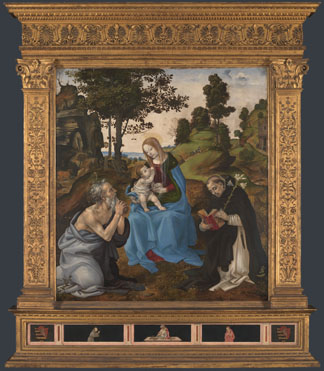
The Virgin and Child with Saints Jerome and Dominic by Filippino Lippi - picture taken from the website of the National Gallery
As I said above, I am not one who is a big fan of looking at old paintings for hours on end, but I know the big names and can recognize my fair share of famous paintings. One of the things I appreciated and was in awe of most about the National Gallery was the sheer volume of paintings they had that I was familiar with. There was one room with twenty-one paintings on the walls and I counted nine by Raphael and two by Michelangelo. (I came to realize that you could tell where a really famous painting or artist’s work was when there was a massive group of people surrounding it and traffic stopped flowing.) The US has some really nice art museums, but the content of the National Gallery blew my mind.
The main thing I learned today is that art and music transcend all language barriers. I probably heard people speaking at least a dozen different languages when I was strolling around the National Gallery and sitting in Saint-Martin-in-the-Fields, but it didn’t matter because everyone can enjoy art and it is completely open to interpretation.
Tags: Kelley
Today’s class centered around a discussion of how immigrant and minority populations in London have either struggled or been able to assimilate. We examined specific groups and religions and attempted to define exactly what assimilation entails. Kelley brought up a great point about how some groups that come to London have no interest in assimilation. They come simply to get an education, make some money and share what they’ve learned once they return to their country of birth. This complicates the assimilation process even more. What can we do as educated young people to help minority groups achieve assimilation? Do they want our help at all? These are some questions I am going to continue to wrestle with for the remainder of my time in the U.K.
After class today I had an afternoon filled with art, both musical and visual. A lunchtime concert at historic St. Martin in the Fields featured a fantastic three man ensemble called E.L.F. Made up of a pianist Geoff Eales, french horn player Dave Lee and flautist Andy Findon the group put on an incredible performance highlighted by an extraordinary 40 minute take on Andrew Lloyd Webber’s “The Phantom of the Opera”. The music was moving and captivating throughout and at the end of “All I Ask of You” I was left with goosebumps from head to toe. As someone who played trumpet and a little bit of French Horn throughout high school I was amazed by the richness of the sound Mr. Lee produced. It was superior to anything I had ever heard performed in the past. The church’s incredible acoustics certainly had a major impact on the groups resounding sound as well turning a three man ensemble into what sounded like a full fledged orchestra. One action that took place during the concert that Brandon and I were pondering was whether it is customary for performers to exit the stage completely while the audience applauds and then return for the next number shortly after. We were unsure if this was something unique to England, unique to St. Martins in the Fields or whether the group chose to do so at their own discretion. In any event it was something we had never seen before.
After the concert Aidan, Brandon and I headed over to the National Gallery where we gazed at thousands of works of art from all different countries and time periods. I do not know much about visual art and what techniques are used to make paintings considered great but I was continually amazed and impressed by the amount of detail these artists put into their work. Even the smallest stroke of a paintbrush can change a painting entirely. We spent a number of hours inside the National Gallery gazing at everything from Van Gogh to Manet to Van Brugh. Visual art is not my forte nor my specialty but I was very impressed and would go back to the museum in a heartbeat.
After our tour of the National Gallery we headed back out to Trafalgar Square. The rain had let up and the square was alive with all kinds of people. There was protesting, dancing, singing and any number of exciting things going on. We took an abundance of pictures while in the area, attempting to catch all the excitement that was taking place as well as capturing the various monuments in the area such as Nelson’s Column and St. Martin in the Fields.
The final stop in our afternoon included a tour of the National Portrait Gallery, just down the road from St. Martin in the Fields. Inside we viewed portraits of everyone from Princess Diana to T.S. Eliot. My favorite part of the portrait gallery was the section they featured on the Bloomsbury Group. Portraits of Virginia Woolf, E.M. Forster and Lytton Strachey just to name a few were found inside this area. After going on the Bloomsbury walk the day before with Professor Qualls the information was still fresh in my mind and I was able to make connections between the tour and the exhibit. This was fascinating.
I can safely say that this has been my favorite day in London so far. A stimulating discussion, an unbelievable concert, a walk through an internationally recognized museum and time spent with friends adds up to a wonderful and busy day. I hope that the rest of our time spent in London will follow suit.
Tags: Churches and Cathedrals · Henry · Museums

Yesterday, among the jam-packed day of activities (Passing the Tower of London and following the Roman wall, seeing the Museum of London, and visiting St. Paul’s), I went on a Qualls-guided-tour of the Bloomsbury district. For those of you who don’t know what the Bloomsbury Group is, they were about the hippest, coolest, people in the 20th century. They were artists and writers who threw elaborate cool parties and talked about politics and sometimes even swapped partners (homosexuality was still illegal in England at this time)!

Bloomsbury Plaque
How do I know all this, you ask? Well it’s because I know everything! Actually, I spent my second semester of last year pretty much completely immersed in a course called, Forester’s England, taught by Professor Wendy Moffat. While writer E. M. Forster himself was not a member of the Bloomsbury group, it was through this class that I learned so much about the group, its members, and their importance to the time period and England’s history. With all this in mind, it was probably one of the most exciting things I will do during this London course, to stand where these great, free spirited, free thinking people stood. Knowing all that was on the lone, these artists and writers strove to change the society before them. Being able to see where that was happening was truly amazing.

Virginia Woolf Bust
After our class discussion this morning about English people’s connection to their country’s history, and their “English Pride,” it is even more exciting to think about the Bloomsbury group and just how revolutionary their ideas and way of life were. Even the idea of political change is not something most everyday English people think of, let alone act on! As an artist myself, I know the power of the creative arts as motivation for political change and activism.
Standing where Virginia Woolf once stood, where John Maynard Keynes once discussed his economic theories, where Vanessa Bell once must have visited her sister and painted, I only hope that someday my creative efforts can achieve as much as theirs did.
Below is a slide show of photos from my full day, including the Bloomsbury tour, St. Paul’s, and the Museum of London.
Tags: Megan
August 23rd, 2009 · 1 Comment
From the minute we moved into the “London, Sugar, and Slavery” section of the Docklands Museum I think we all knew it was going to be something different; something unlike other things we typically see when at a museum. Being a very visual person I was immediately drawn to a video that began as we entered the area. The film was the reading of a diary of an enslaved African (as the Dockland Museum’s terminology sign stated it would refer to slaves as). Images of different people mouthing the words of his diary flashed across the screen along with other scenic and touristy images of London, as a man’s voice spoke it and the words of the entry scrolled along the bottom. The letter ended with the final words, “someday I hope this will all end, and we will all be free.” I simple wish of a man who could do nothing besides hope for the best in the future.
Keeping that video in mind I strolled through the remainder of the exhibit reading the signs and refreshing my memory of what I have learned about slavery in the past. But when I got to the end of the exhibit I immediately stopped in my tracks. The final wall in this area as entitled “Loss & Liberty” and featured modern ceramic artwork paired with poetry.
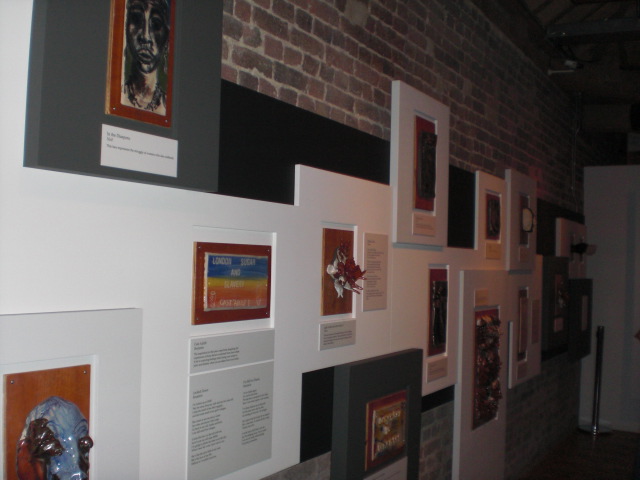
Loss & Liberty
I moved through the artwork and poems slowly, taking in each one as it came. The Caribbean rose, the faces of strained men and women, and the repetition of these images returned my thoughts to the video from the beginning of the exhibit. The repeated modern images and the eloquent words of the enslaved African from the past, paralleled with the ceramics and the words of current men who have experienced, have heard, or are experiencing similar thoughts and feelings as the man did writing in his diary in the 1700s. At that moment the exhibit all came together for me in a world of history, art, and culture all uniting, blurring, and mixing– into one.
To read more about my time in London/UEA and to see more pictures visit: http://amandaepower.blogspot.com/
Tags: Amanda · Museums
Our day began at nine when we left the Arran House and took the tube down to Borough Market. Arriving there early is key because it became quite crowded in the ensuing hours. The market itself is a diverse collection of vendors selling every kind of food imaginable. Ever had a prawn sandwich? How about some rose flavored Turkish delight? Anthony wasn’t so keen on the former, but you get the idea.
Although the market included common grocery items such as fruit, vegetables, and bread, we also saw more unique items on display such as venison, ostrich meat, lassi, and a hanging puffer fish. All suburban Americans have had full meals comprised of free samples. After today, Costco will never be the same. We tasted a wide array of ethnic candies, chutneys, spreads, and much more. Our senses were tickled by the delicious smell of fresh curry, strange meat being butchered, and gorgeous, albeit expensive flowers on display.
After having our fill of distinctly non-American food, we proceeded to the adjacent Southwark Cathedral, the oldest gothic church in London. We all agreed that it is the most beautiful building we have ever set foot in. A place of worship for 1400 years (that’s right, this place is over a millennium old), it was filled with intricate stained glass windows, ornate carvings, and imposing statues. Most interestingly, the tombs of many of the church’s benefactors are located both beneath the floor and on display inside the cathedral itself. Perhaps the most haunting of these was the frighteningly realistic “emaciated corpse” carved from stone in the 14th Century. Some of the church’s most famous frequenters included Dickens, Chaucer, and Shakespeare, who is immortalized in statue.
Next, we stumbled upon a life-sized replica of Sir Francis Drake’s galleon, the Golden Hinde, one of the first of its kind to circumvent the globe. Having travelled over 140,000 miles, we were blown away by its sheer size and intricacy. Also, what the hell was a ship doing in the middle of the street? Whatever.
The highlight of our day was the Menier art gallery. Managed by an old British couple, the building was unassuming and tucked away, separated from the hustle and bustle of the marketplace. The gallery housed a small but diverse mix of works spanning a myriad of artistic schools and styles. We enjoyed chatting with the charming proprietors, who graciously told us about their upbringings in northern England. This was masterfully illustrated by paintings by one of the owners. One was of a line of houses overlooking a serene beach and rocky white cliffs. Incredibly, this same placid beach was heavily fortified with barbed wire during WWII to prevent a German invasion. Hitler decided to try to pull a Napoleon and attempt to conquer Russia instead. We all know how that turned out. The couple still visits their childhood town today.
Overall, our time in the Borough was an exceedingly positive experience. If you are looking for widely mixed collection of cultures selling their foods and wares, this is the place for you. We fancy returning in the future. However, a word of advice: try to avoid Bank tube station any time after 10 AM. The extreme congestion made our journey home more difficult, as the wonderful aroma of body odour (note the spelling) invaded our nostrils.
Tags: Amy · Andrew B · Anthony
August 21st, 2009 · 1 Comment
After little sleep, I awoke this morning at 7:30 to begin my journey down the Thames rive; the first event of this trip to really make me feel like I was in London. Coming from New York City, I am used to city life, trains, buses, and lots of people. So exploring the city on our first day and learning the tube was a little less exciting for me. As I walked the streets and rode the train I felt almost like I was still back home, that the plane had circled JFK for 6hrs and 55mins and then just put me back where I started.

Big Ben
But that feeling disappeared as soon as I stepped onto the Ferry boarding dock and spotted Big Ben in the distance. Instantly I realized that there was nothing like this back home. After snapping way too many photos of the distance clock tower, we boarded the Ferry which would take us down the river.
I found the Ferry ride itself to be mostly relaxing, especially considering the low amount of sleep I was running on. We docked near a dirt beach and headed on our long walking tour around Greenwich. Although I found the history and fun facts that we learned along the way interesting, what really got me excited was the details of the architecture. Not only was every single building ornaments with ionic or corinthian columns, but also faces, family crests, and shields. As an art minor, I find the time spent on the monuments and decorative elements of London to be the most beautiful thing about it.

Royal Observatory
For example, when I visited the Royal Observatory today, it was not the clock museum, the view from the telescope tower, or even the amazing planetarium show that I loved most about that part of our day tour, but rather the gorgeous and detailed buildings that housed these things.

"Astronomia" Mermaid Relief
Just as I left the planetarium show (which I encouraged everyone to attend, and turned out to be a huge success!) I spotted a mermaid relief low on the wall across from the exit. On a closer look I found the word “Astronomia” engraved on it. I found that these small details and reliefs awakened my passion for visual arts that the historical facts and information never could.
That is another element of this city that really differs from my home city. Although the architecture of New York will always have a special place in my heart, it lacks the ancient and authentic hand crafted beauty that the old buildings of London have. There is always something very striking to me about the juxtaposition of the modern buildings against the classical structures that founded this city. It is almost like there is a continuing battle between history and modernization. Unfortunately for my passion, it looks like modernization is winning.
If you would like to continue following my adventures, feel free to visit my photo page for a slide show tour of some of the sites I have seen over the past two days: http://s644.photobucket.com/albums/uu163/mliberty2011/London%20the%20first%20two%20days/?albumview=slideshow
After little sleep, I awoke this morning at 7:30 to begin my journey down the Thames rive; the first event of this trip to really make me feel like I was in London. Coming from New York City, I am used to city life, trains, buses, and lots of people. So exploring the city on our first day and learning the tube was a little less exciting for me. As I walked the streets and rode the train I felt almost like I was still back home, that the plane had circled JFK for 6hrs and 55mins and then just put me back where I started.

Big Ben
But that feeling disappeared as soon as I stepped onto the Ferry boarding dock and spotted Big Ben in the distance. Instantly I realized that there was nothing like this back home. After snapping way too many photos of the distance clock tower, we boarded the Ferry which would take us down the river.
I found the Ferry ride itself to be mostly relaxing, especially considering the low amount of sleep I was running on. We docked near a dirt beach and headed on our long walking tour around Greenwich. Although I found the history and fun facts that we learned along the way interesting, what really got me excited was the details of the architecture. Not only was every single building ornaments with ionic or corinthian columns, but also faces, family crests, and shields. As an art minor, I find the time spent on the monuments and decorative elements of London to be the most beautiful thing about it.

Royal Observatory
For example, when I visitied the Royal Observatory today, it was not the clock museum, the view from the telescope tower, or even the amazing planetarium show that I loved most about that part of our day tour, but rather the gorgeous and detailed buildings that housed these things.

“Astronomia” Mermaid Relief
Just as I left the planetarium show (which I encouraged everyone to attend, and turned out to be a huge success!) I spotted a mermaid relief low on the wall across from the exit. On a closer look I found the word “Astronomia” engraved on it. I found that these small details and reliefs awakened my passion for visual arts that the historical facts and information never could.
That is another element of this city that really differs from my home city. Although the architecture of New York will always have a special place in my heart, it lacks the ancient and authentic hand crafted beauty that the old buildings of London have. There is always something very striking to me about the juxtaposition of the modern buildings against the classical structures that founded this city. It is almost like there is a continuing battle between history and modernization. Unfortunately for my passion, it looks like modernization is winning.
If you would like to continue following my adventures, feel free to visit my photo page for a slideshow tour of some of the sites I have seen over the past two days: http://s644.photobucket.com/albums/uu163/mliberty2011/London%20the%20first%20two%20days/?albumview=slideshow
Tags: Megan
We started off our first adventure in London by taking a boat ride down the Thames River. It was the first time I really felt like I was IN LONDON. Seeing the London Eye and Big Ben from a distance, really set me into reality. As we rode down the river it was fascinating to see the old architecture and homes along the river. Upon arriving in Greenwich we walked through the park and arrived at the Prime Meridian. After straddling the line so I was in two hemispheres at once, and wandering around the museums we decided to take advantage of the planetarium. After more walking around Greenwich and having lunch (which despite my picky eating habits was surprisingly delicious), I went with a small group to the Queens House.
To me the most impressive thing about the Queens House was the size and the architecture. Wandering from room to room I couldn’t even focus on the paintings that covered the walls, I was shocked by the beauty of the crown molding and wainscoting. And it continued from room to room to room. As we left Greenwich we walked through the tunnel that went under the Thames and took the railroad to the Tube and took the Tube home.
I felt that the boat ride down the Thames was a good introduction to London seeing some of the major sight-seeing sites, I’m looking forward to seeing more though. I enjoyed hearing about the area of Greenwich, but what I’m especially looking forward to is seeing some modern art, dance, and plays. I know it’s coming, and I know I need to seek it out and I can’t wait!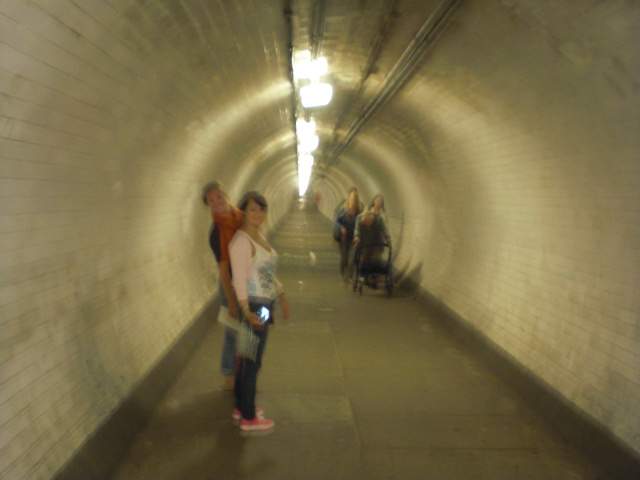

Tags: Amanda




